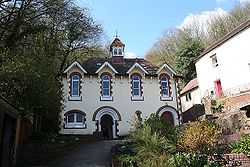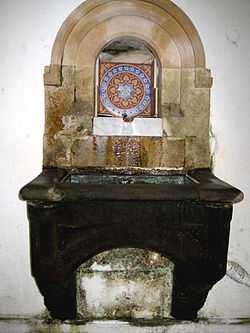Holy Well, Malvern

The Holy Well is set on the slopes of the Malvern Hills above Malvern Wells. The well is believed to be the site of the oldest bottling plant in the world.[1] The Malvern spring water was first bottled on a commercial scale at the well and the building houses a modern commercial bottling plant.
History

The Holy Well was granted to John Hornyold Esq in 1558.
In 1743 Dr John Wall analysed the spring water. He published his analysis of the water, stating that the water contained "nothing at all".
Edward Popham of Tewkesbury erected the first bath house at the Holy Well in 1747.
In 1843 it was purchased by T G Hornyold, who erected the cottage orne-style building that houses the Well at a cost of £400.
The building was listed as Grade II and of Architectural Interest in the 1970s.[2]
Bottling at the Holy Well

Malvern water has been bottled and distributed in the UK and abroad from as early as the reign of James I,[3] with water bottling at the Holy Well being recorded in 1622.[4] Various local grocers have bottled and distributed Malvern water during the 19th and early 20th centuries, but it was first bottled on a large commercial scale by Schweppes, who opened a bottling plant at Holy Well in Malvern Wells in 1850. As official caterers to the Great Exhibition of 1851,[5] Schweppes introduced the water as Malvern Soda,[6] later renaming it Malvern Seltzer Water in 1856.[7][8] In 1890 Schweppes moved away from Holy Well, entered into a contract with a Colwall family, and built a bottling plant in the village in 1892.[7][9] The Holy Well was subsequently leased to John and Henry Cuff, who bottled there until the 1960s.[10][11][12] The Holy Well became derelict until 2009 when with the aid of a Lottery Heritage grant, production of 1200 bottles per day of Holy Well Spring Water was recommenced by an independent family-owned company.[10]
Folklore
In the past Holy Well was dressed on St. Oswald's day by people who had been cured at the well. St Oswald supposedly revealed the healing properties of the well to a hermit who lived on the hills.[13]
Until 2006, religious items, flowers and other objects were left as votive offerings at the Holy Well. Local Christians and foreign visitors of a wide range of faiths used to leave prayers and wishes in thanks for the pure water. In 2006 concerns were raised in the local press about religious messages that had been written on the walls of the building. As a result, tokens are regularly removed with the exception of the official well dressing of the site in May.[14][15][16][17]
In Early British Trackways Alfred Watkins theorised that a ley line passed along the Malvern Hills through several wells including Holy Well, St Ann's Well, Walms Well and St. Pewtress Well.[18]
Further reading
- Rose Garrard: 2006, Malvern: Hill of Fountains — Ancient Origins, Beliefs and Superstitions surrounding Wells and Well Dressing ISBN 1-905795-01-7
- Bruce Osborne & Cora Weaver: 1994, Aquae Malvernensis — The Springs and Fountains of the Malvern Hills ISBN 1-873809-07-7
See also
External links
References
- ↑ "Historic bottling plant at Holy Well open for business again", Malvern Gazette (Newsquest Media Group), 9 November 2009, retrieved 22 May 2011
- ↑ Weaver, Cora; Osborne, Bruce (1994). Aquae Malvernensis — The Springs and Fountains of the Malvern Hills. Cora Weaver. ISBN 1-873809-07-7.
- ↑ Smart, Mike (2009), The Malvern Hills, London: Frances Lincoln Ltd, p. 17, ISBN 978-0-7112-2915-0, retrieved 22 May 2011
- ↑ Great Malvern Conservation Area: Appraisal and Management Strategy, Malvern Hills District Council: Planning Services, April 2008, p. 5, retrieved 22 May 2011
- ↑ Briggs, Asa (7 May 1981), "Pictures at an exhibition", New Scientist 90 (1252): 366, retrieved 22 May 2011
- ↑ Moskowitz, Milton (1987), The global marketplace: 102 of the most influential companies outside America, New York: Macmillan, p. 121, ISBN 0-02-587590-6, retrieved 22 May 2011
- ↑ 7.0 7.1 Official Malvern Water brochure. Coca-Cola Enterprises Limited. 2009.
- ↑ "Schweppe's Malvern Seltzer Water", Medical Times and Gazette Advertiser, Vol 12 – New series (301), April 5, 1856: 328, retrieved 22 May 2011
- ↑ About Colwall, Herefordshire Council Parks, Countryside and Leisure Development Service (Funded by Malvern Hills AONB Partnership), 2008, retrieved 22 May 2011
- ↑ 10.0 10.1 "Holy Well". Malvern Spa Association. Retrieved 22 May 2011.
- ↑ McComb, Richard (July 24, 2009), "Water, as nature intended", Birmingham Post (Trinity Mirror Midlands Ltd), retrieved 22 May 2011
- ↑ Richardson, Linsdall (1930), Wells and springs of Worcestershire, (Memoirs of the Geological Survey, England and Wales), London: HM Stationery Office, p. 119, retrieved 22 May 2011
- ↑ Winsor, John (1981), : What to see in Malvern, Winsor Fox Photos, ISBN 0-9507540-0-5
- ↑ "Let's keep the damage in perspective", Malvern Gazette (Newsquest Media Group), 7 April 2006, retrieved 22 May 2011
- ↑ "Religious graffiti found on well wall", Malvern Gazette (Newsquest Media Group), 24 March 2006, retrieved 22 May 2011
- ↑ "Newsletter No. 13. March 2006". Friends of Malvern Springs and Wells. Retrieved 22 May 2011.
- ↑ Garrard, Rose (2010), : An Illustrated History of Its People and Places Troubles and Treasures in Fact and Fable, Aspect Design, p. 111, ISBN 1-905795-56-4
- ↑ Watkins, Alfred (1921). Early British Trackways, Moats, Mounds, Camps, and Sites.
| ||||||